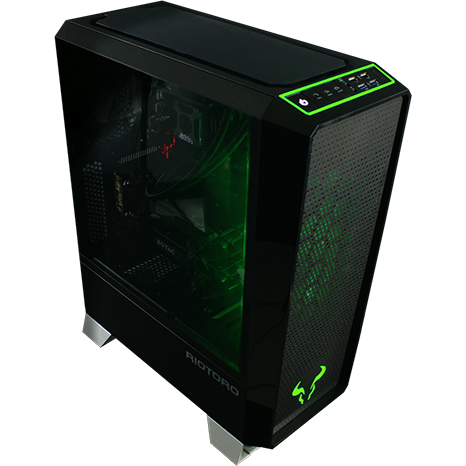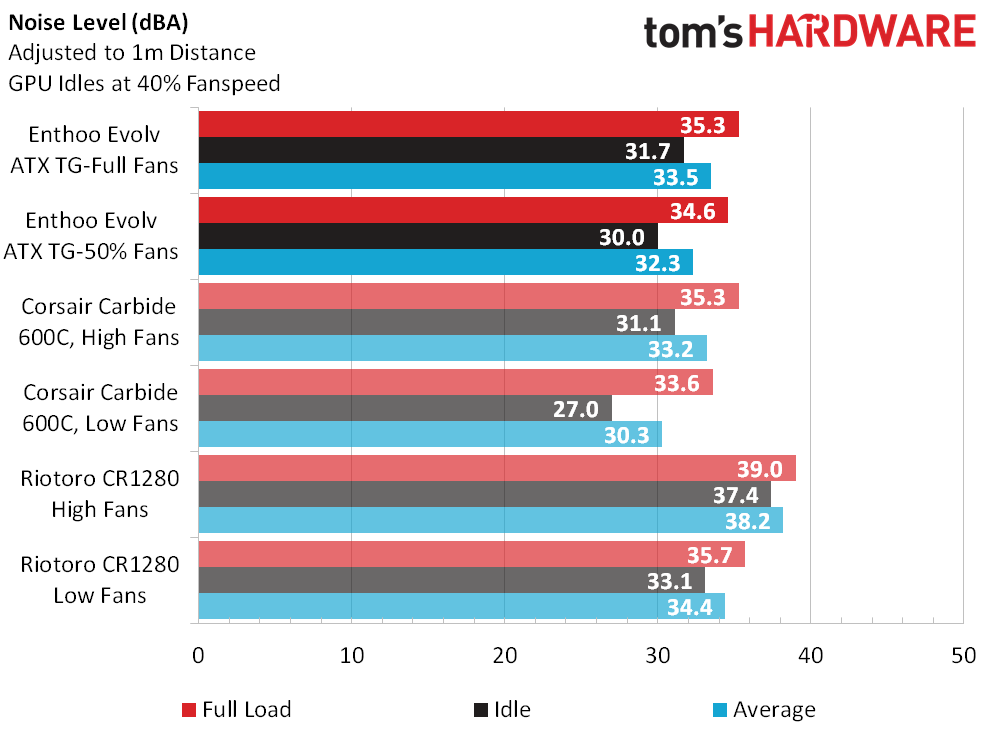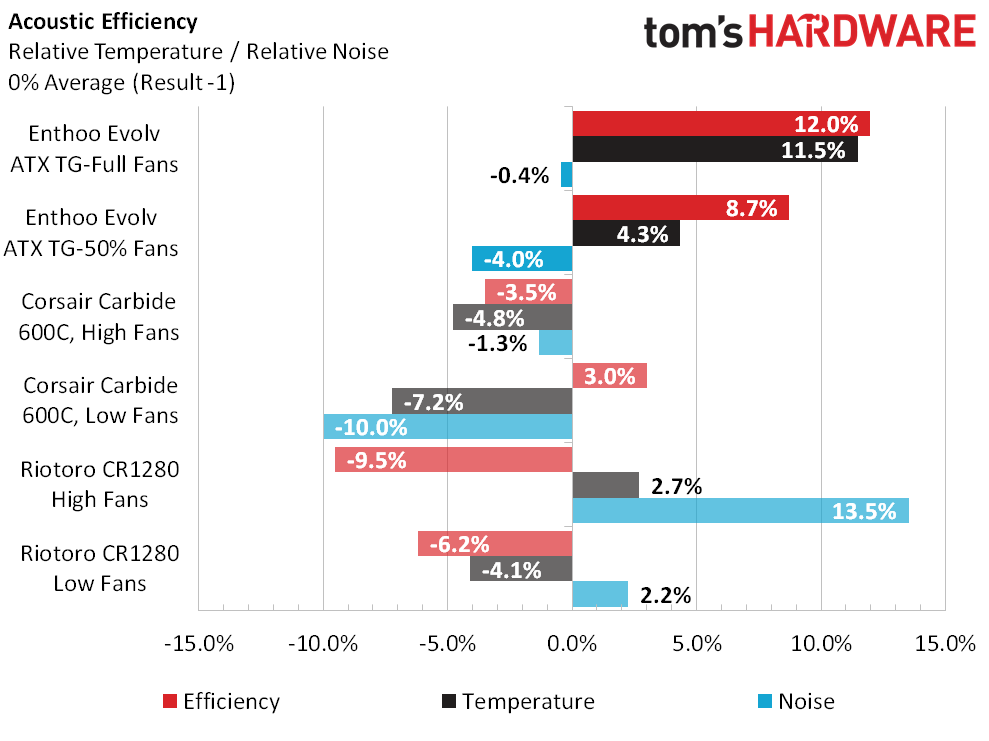Phanteks Enthoo Evolv ATX Tempered Glass Mid-Tower Case Review
Why you can trust Tom's Hardware
Test Results And Conclusion
We continue to use our reference PC with its reference overclock for case testing, apart from replacing the X99S XPower AC with the X99S Gaming 7. That replacement has allowed us to compare tighter "Standard ATX" cases, since the XPower motherboard is oversize.
Noise is measured .5m from the case's front corner, on the side that opens. The numbers are corrected to the 1m industry standard -- used by many loudspeaker and fan manufacturers -- by subtracting six decibels.
Drivers And Settings
| Chipset | Intel INF 9.4.2.1019 |
|---|---|
| CPU | 4.2GHz (42x 100MHz) @ 1.2V Core |
| Motherboard | Firmware 17.8 (02/10/2015) |
| RAM | XMP CAS 16 Defaults (1.2V) |
| Graphics | Maximum Fan for Thermal Tests | Nvidia GeForce 347.52 |
Comparison Cases
Test Results
The Enthoo Evolv ATX Tempered Glass starts out with remarkably cool temperatures, given the relatively small size of our CPU cooler. Even when handicapped to a 50 percent duty cycle by the motherboard's PWM-based fan controller, it outpaces our two most closely-priced mid-tower review samples.
Tempered glass side panels help isolate internal component noise in the Evolv Tempered Glass case, though the close proximity between full-fan and 50 percent duty-cycle still indicates that internal components make up the bulk of the noise detected. Comparatively, the other two cases appear to get a larger portion of total noise from case fans.
An improved cooling-to-noise ratio results from better cooling at similar noise levels, as the Phanteks Enthoo Evolv ATX Tempered Glass takes a lead in overall performance.
Unfortunately, the Enthoo Evolv ATX Tempered Glass also costs about 25 percent more than the Carbide 600C, putting it at a competitive disadvantage in the value comparison.
Pitting a 12 percent performance advantage against a 6 percent value disadvantage could create a problem for our final analysis, but it doesn't need to. If you're willing to spend an extra $30 for the Enthoo Evolv ATX Tempered Glass's 3mm-thick aluminum face, top panel, and feet, and then another $10 for the tempered glass side panels, you're still left with that 12 percent performance advantage. Fussy buyers should have no problem making that justification.
Get Tom's Hardware's best news and in-depth reviews, straight to your inbox.
On the other hand, the award contention remains contentious. Due to the value score, it's impossible to give this one our "Recommended" stamp of approval. And while it would qualify for our "Editors' Choice" award, the fact that it can't hold a 10.7inch-deep motherboard or a (double slot) graphics card in the motherboard's bottom slot means I probably wouldn't choose it for a premium system. You might. Better performance qualifies it for our "Approved" award, without forcing me to make any quality-based justifications.
MORE: Best CasesMORE: Cases in the News
MORE: All Case Content
MORE: Cases in the Forums
Thomas Soderstrom is a Senior Staff Editor at Tom's Hardware, covering Cases, Cooling, Memory and Motherboards. Follow him onTwitter.
Follow us on Facebook, Google+, RSS, Twitter and YouTube.
Current page: Test Results And Conclusion
Prev Page Building Inside The Enthoo Evolv Glass Case-
Crashman Reply
This sample is so nice it almost makes it worth the wait! J/K, they should have sent samples before this. But it is pretty nice and nicely pretty.17908420 said:Almost make me want to swap my Fractal Design XL R2...
-
falchard There is no knocking the tempered glass. Nearly all cases using tempered glass look fantastic. Mine is the inWin 904. It looks absolutely gorgeous, although its liquid cooling options are limited on the initial production run.Reply -
g-unit1111 Reply17908446 said:There is no knocking the tempered glass. Nearly all cases using tempered glass look fantastic. Mine is the inWin 904. It looks absolutely gorgeous, although its liquid cooling options are limited on the initial production run.
The In Win 904 is sweet. The price was the only thing keeping me from getting it over the Enthoo Pro that I have now. I really like this case though. -
Luay Tom I couldn't rap my head around the clearance for the second GPU.Reply
So in a four slot Z170 ATX motherboard like the Asus WS or Asrock Formula with SLI/CF, the second card would go in the third slot;
How close is a double slot card to the PSU shroud? What about triple slot? -
Crashman Reply
I have no idea what you're asking, but I can answer a bunch of questions until I hit the right one perhaps?17909065 said:Tom I couldn't rap my head around the clearance for the second GPU.
So in a four slot Z170 ATX motherboard like the Asus WS or Asrock Formula with SLI/CF, the second card would go in the third slot;
How close is a double slot card to the PSU shroud? What about triple slot?
There's only about 1/2" of clearance between the bottom slot cover and the PSU shroud. You'll never get a double-slot card in the motherboard's bottom slot. But that's usually the third or fourth GPU, not the second.
Your concern about the second GPU is mostly dependent on the location of the second-card's slot. If it's the third slot position from the bottom, you'll have about 2.8" of space for the graphics card. Add about 0.8" if it's one slot higher. Subtract 0.8" if it's one slot lower.
-
G0nz0 been waiting on a review for these cases fora long time. im happy they dont dissapoint. pricing really isnt that big of an issue when u factor in component cost aswell not to mention the amount of additional components they offer for the WC crowd to make your life exponentially easier. ill definetly be going with one of their cases for my next build. just cant decide between this one or the dual build case, both are temptingReply -
Luay Ok I did the math. What I meant was , On a full ATX board with 4 PCI-E slots, how close is the second card to the PSU shroud if installed in the third PCI-E slot from the top. The answer should be 2". I assume that would choke a triple slot video card.Reply -
Nuckles_56 That is a very nice case, I'm now very much considering it for my next build, especially if I decide to go with a full custom loopReply






